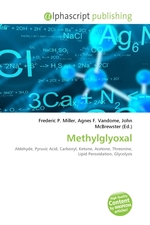Methylglyoxal
Frederic P. Miller, Agnes F. Vandome, John McBrewster
бумажная книга
High Quality Content by WIKIPEDIA articles! Methylglyoxal, also called pyruvaldehyde or 2- oxopropanal (CH3-CO-CH=O or C3H4O2) is the aldehyde form of pyruvic acid. It has two carbonyl groups, so it is a dicarbonyl compound. Methylglyoxal is both an aldehyde and a ketone. In organisms, methylglyoxal is formed as a side-product of several metabolic pathways. It may form from 3-amino acetone, which is an intermediate of threonine catabolism, as well as through lipid peroxidation. However, the most important source is glycolysis. Here, methylglyoxal arises from non enzymatic phosphate elimination from glyceraldehyde phosphate en dihydroxyacetone phosphate, two intermediates of glycolysis. Since methylglyoxal is highly cytotoxic the body developed several detoxification mechanisms. One of these is the glyoxalase system. Methylglyoxal reacts with glutathione forming a hemithioacetal. This is converted into S-D-lactoyl- glutathione by glyoxalase I, and then further metabolised into D-lactate by glyoxalase II.
Данное издание не является оригинальным. Книга печатается по технологии принт-он-деманд после получения заказа.


